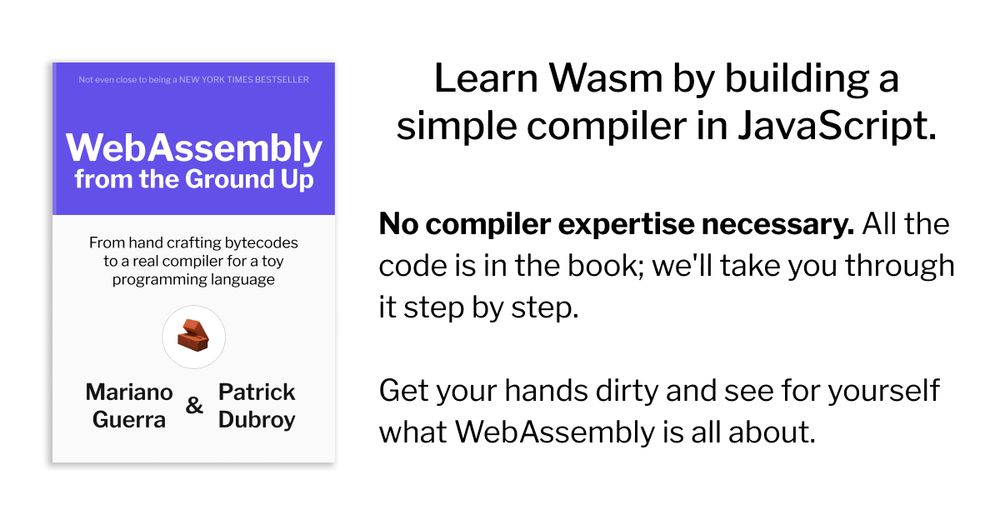
📘 Co-author of https://wasmfromthegroundup.com/
📰 Future of Coding Weekly: https://newsletter.futureofcoding.org/join/
After years of engineering, design, and community collaboration, we’re excited to announce this milestone!
Spread the word!

After years of engineering, design, and community collaboration, we’re excited to announce this milestone!
Spread the word!


🎙️ TodePond and Dave Ackley
🎼 Thuja: Algorithmic composition with Csound
🧑💻 OpenAI constrained generation with Context‑Free Grammar
🔗 newsletter.futureofcoding.org/posts/future...

🎙️ TodePond and Dave Ackley
🎼 Thuja: Algorithmic composition with Csound
🧑💻 OpenAI constrained generation with Context‑Free Grammar
🔗 newsletter.futureofcoding.org/posts/future...
A WebAssembly interpreter (Part 1)
→ wasmgroundup.com/blog/wasm-vm...
We build up a simple interpreter from scratch, in JavaScript, for a small subset of Wasm instructions (arithmetic and comparison).

2026.programming-conference.org/home/substra...
2026.programming-conference.org/home/substra...
sonic-pi.net/supersonic/d...
Hopefully you'll have a lot of fun playing with the demo and it will leave you with a strong sense of wanting more.
That more will be Tau5...

sonic-pi.net/supersonic/d...
Hopefully you'll have a lot of fun playing with the demo and it will leave you with a strong sense of wanting more.
That more will be Tau5...
2026.programming-conference.org/home/substra...
2026.programming-conference.org/home/substra...

Demo of a prototype I'm working on to play with structure editors and ways to make WebAssembly easier to understand.
www.youtube.com/watch?v=liJg...

Demo of a prototype I'm working on to play with structure editors and ways to make WebAssembly easier to understand.
www.youtube.com/watch?v=liJg...

📝 Explorable explorable explanations
💡 SYNIT: a reactive operating system
📝 Open Source Power
🔗 newsletter.futureofcoding.org/posts/future...

📝 Explorable explorable explanations
💡 SYNIT: a reactive operating system
📝 Open Source Power
🔗 newsletter.futureofcoding.org/posts/future...

How to generate small & performant syntax highlighting for your languages using OhmJs and the new CSS.highlights API
www.youtube.com/watch?v=v3jK...
Repo: github.com/marianoguerr...
Demo: marianoguerra-atik.github.io/ohm-highlight/

How to generate small & performant syntax highlighting for your languages using OhmJs and the new CSS.highlights API
www.youtube.com/watch?v=v3jK...
Repo: github.com/marianoguerr...
Demo: marianoguerra-atik.github.io/ohm-highlight/
Con muchísima alegría @manux.bsky.social y yo les contamos que ya liberamos el libro "Python para Ciencia y Tecnología", completo, en castellano… ¡y totalmente gratis! 😍📘
💾 Pueden descargar el PDF desde 👉 libropython.science
Con muchísima alegría @manux.bsky.social y yo les contamos que ya liberamos el libro "Python para Ciencia y Tecnología", completo, en castellano… ¡y totalmente gratis! 😍📘
💾 Pueden descargar el PDF desde 👉 libropython.science
🧠 micrograd
🎥 I am not dead yet
📝 The Hidden Gem in S/SL: Why Dataless Languages Matter
🔗 newsletter.futureofcoding.org/posts/future...

🧠 micrograd
🎥 I am not dead yet
📝 The Hidden Gem in S/SL: Why Dataless Languages Matter
🔗 newsletter.futureofcoding.org/posts/future...
find . -name '*_res.json' -exec jq '.parsing_res_list[].block_label' {} \; | awk '{count[$0]++} END {for (i in count) print count[i], i}' | sort -nr
find . -name '*_res.json' -exec jq '.parsing_res_list[].block_label' {} \; | awk '{count[$0]++} END {for (i in count) print count[i], i}' | sort -nr
Authors Patrick @dubroy.com and @marianoguerra.org think it's crucial for learning. They join #WasmAssembly host Thomas Steiner to discuss their ebook, "WebAssembly from the Ground Up" → goo.gle/3Ln67Pp

Authors Patrick @dubroy.com and @marianoguerra.org think it's crucial for learning. They join #WasmAssembly host Thomas Steiner to discuss their ebook, "WebAssembly from the Ground Up" → goo.gle/3Ln67Pp
On the fact that the Atlantic Ocean has two sides 2.0

On the fact that the Atlantic Ocean has two sides 2.0
github.com/WebAssembly/...
Also immortalized in song: suno.com/song/19e0679...

github.com/WebAssembly/...
Also immortalized in song: suno.com/song/19e0679...
If you are interested in a hands-on way to learn #wasm, check out the book that @marianoguerra.org and I wrote together!
It's the book we wish we'd had 3 years ago.
No messing with tools and frameworks. It's a hands-on guide to the core of Wasm: the instruction set and module format.
Link below. 👇

If you are interested in a hands-on way to learn #wasm, check out the book that @marianoguerra.org and I wrote together!

Dodrio (by Nick Fitzgerald) is an experimental virtual DOM library for Rust and Wasm. It uses bump allocation for the VDOM nodes and uses a stack machine language to represent change lists: github.com/fitzgen/dodrio

Dodrio (by Nick Fitzgerald) is an experimental virtual DOM library for Rust and Wasm. It uses bump allocation for the VDOM nodes and uses a stack machine language to represent change lists: github.com/fitzgen/dodrio
we're a small team on a mission to spread the joy of programming
we're looking for someone self-directed, loves talking to users, write english & typescript, and own projects end-to-end
if this is you, reach out!!

we're a small team on a mission to spread the joy of programming
we're looking for someone self-directed, loves talking to users, write english & typescript, and own projects end-to-end
if this is you, reach out!!


